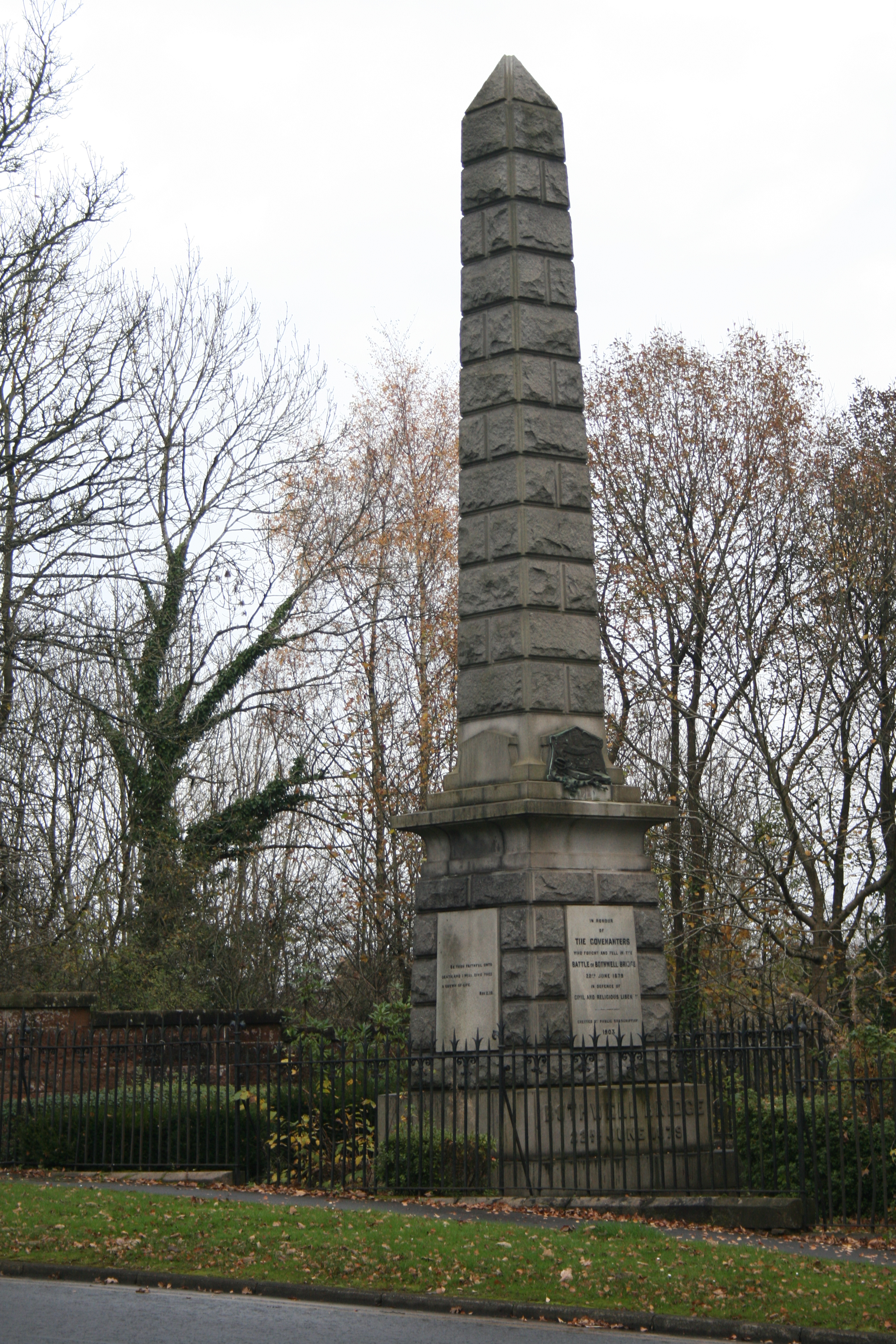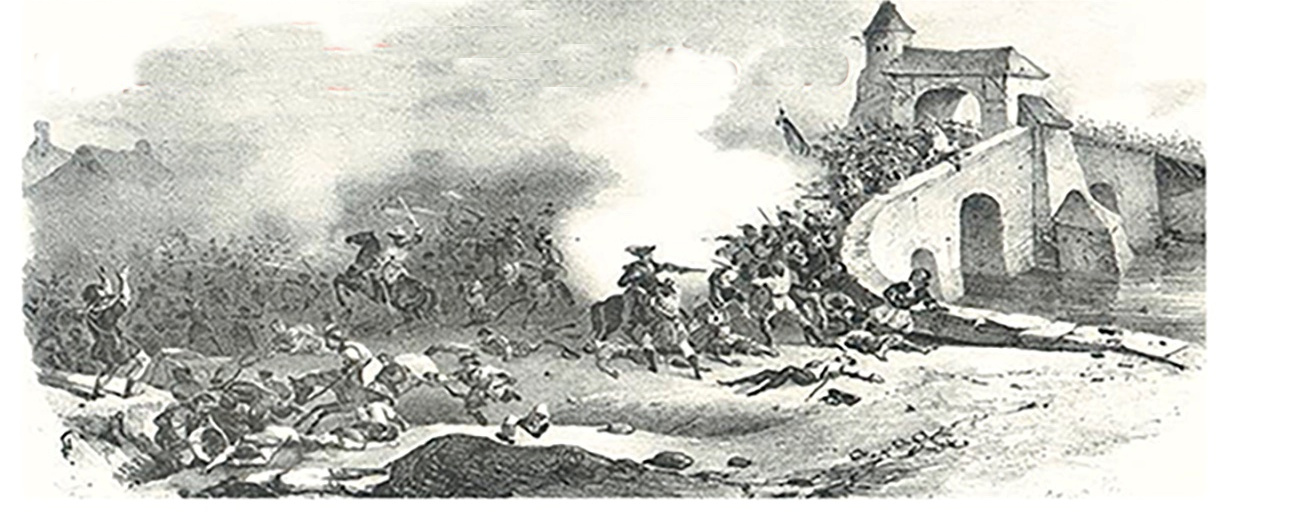Battle of Bothwell Brig, 1679
 |
| The Covenamters' Memorial at Bothwell Brig |
The Covenamters' Memorial at Bothwell BrigBothwell Brig will always
be remembered as a battle of lost opportunities. Following the modest
success at Drumclog three weeks previously the hopes ( and with it
perhaps, the naivety) of the Presbyterians ran high. But they lacked
decisive leadership and spent most of the time arguing amongst
themselves about doctrinal matters. If they had pursued Claverhouse and
his troopers from Drumclog into Glasgow while the iron was hot, there
may have been a different outcome. At the heart of the problem was
Robert Hamilton (later Sir Robert, of Preston), the leader of the
Covenanters elected before Drumclog who had assumed the position at
Bothwell. Along with him were some of the leading ministers who were
against having any of the `Indulged` in the army. Hamilton was a rigid
and unbending opponent of the Indulgences and would have no truck
whatsoever with anyone who had even associated with an indulged person.
This extremism of a few, including the commanding officer, was the
Covenanters` downfall.
There was a broad agreement that the Black
Indulgence, as it was called, was wrong but they began arguing whether
or not it should be expressly condemned in a proclamation which they
were preparing in order to justify their conduct. Thus occupied in
theocratic bickering their minds were not focussed on the job in hand.
The Indulged were Covenanters who favoured compromise and who had
in many cases accepted indulgences from the government. They were in
favour of including in the proposed proclamation that they `owned the
king` ie recognised his right to rule but not the church. Ultimately
this was included and proclaimed at Glasgow on 13 June 1679. They were
still arguing frantically on 21 June when the Duke of Monmouth and some
10,000 troops appeared. The Duke of Montrose commanded the cavalry, the
Earl of Linlithgow led the infantry. Claverhouse led his dragoons, Lord
Mar had a regiment of foot, and the Earls of Home and Airlie brought
their regiments. Still to come, as he waited fractiously for his
appointment, was Dalziel of the Binns who resented being only second in
command on this occasion. Within the Covenanter camp the moderates again
wanted to make representations to the government forces, and with some
duplicity engineered a letter that Hamilton signed, believing it to have
been approved by his principal adviser, the Rev Donald Cargill. The
letter was rejected by the Duke of Monmouth who insisted that the
combatants must surrender to the mercy of the king. The half hour
allowed to make their minds up evaporated as the two factions argued
again and fighting became inevitable. At this juncture there was re-run
of the battle at Dunbar as yet again, many of the `malignant` and
`indulged` officers and men were removed from the army despite the
certainty of battle - literally only minutes away.

Riven by
disagreements, reduced in number, poorly armed with one small brass
cannon, short of supplies, and with poor generalship the 4,000 men of
the Covenanter army was decisively beaten by a substantial force, now of
over 15,000 men . The position of the Covenanters from a military
standpoint was quite good at the beginning. They had between them and
the royalist forces a long narrow bridge that was well fortified, with a
barricade in the middle. To either side there were houses and thickets
on the side of the river which were well defended by the Covenanters.
Although the river was fordable it was a foolish soldier who tried to
cross, as soon became evident when withering musket fire drove them
back. David Hackston and his men held the bridge, Burley ( one of the
murders of Archbishop Sharp) and Captain John Nisbet with their horse
were above the bridge and along the river bank. But in the rear and on
the moor the main body of the Covenanters were still arguing among
themselves as the stalwarts fought fiercely for the cause. Hackston`s
party held the bridge for over an hour but began to run out of
ammunition. Repeated demands for re supply were sent back but all they
received was one barrel that was full of raisins, not gunpowder. They
fought on until overpowered when, too late, the main body realised they
were in trouble; they wavered and some began to run. It was a total rout
in which Claverhouse and his troopers sought their revenge for Drumclog,
even though Monmouth had given the Covenanters quarter.
The
numbers vary with the source but about 400 were killed and about 1200
prisoners were taken, stripped and made to lay down on the moor under
penalty of being shot if they lifted up their heads. These were the
prisoners who were later marched to Edinburgh and penned in the open at
Greyfriars Kirk Yard, where some lingered for five months. The last 250
of these prisoners were sentenced to transportation to the colonies and
about 211 of them drowned on board the `Crown` when the ship sank off
Orkney.
Following Bothwell Brig, and as had happened after the
earlier Pentland Hills rising in 1666, the government made a
Proclamation declaring, both by name and generally, that all
participants were rebels and traitors . Following the Proclamation,
Claverhouse and his troopers were sent in to settle the population. In
Galloway the land owners were summoned before the Judiciary Court on 18
February 1680 where on very dubious evidence (from paid witnesses and
informers) they were declared rebels, sentenced to death in their
absence, and their lands forfeit. Among these were MacDougall of Freugh;
William Gordon of Earlston and his son Alexander; Gordon of Craighlaw;
Gordon of Culvennan; Dunbar of Machermore; and MacKie of Larg. William
Gordon of Earlston had in fact been killed on the way to join his son at
Bothwell Brig, but his name was included so that his lands could be
seized. Into the Galloway region returned John Graham of Claverhouse and
his brother Cornet Graham, who had been given a commission by the Privy
Council to seize the movable property of all who had been in the
rebellion or had fled (from persecution). Much of this found its way
into their own pockets.
The significance of the defeat at
Bothwell Brig was to prove very great. It led directly to a more
systematic oppression on the part of the government; and it drove the
persecuted into deeper seclusion, to the wild moors and uplands further
away from the troopers hunting them down. These were the deep wooded
glens, the morasses where there was only peaty water to drink, the rocky
exposed hills, and lonely dank caves in gorges. Anywhere in fact where
there was shelter and perhaps safety from their pursuers.
Robert
Hamilton fled to Holland where he was a close friend of Mr Brakell,
minister at Leewarden. James Renwick corresponded with both of them and
kept them informed of developments, while Hamilton made a contribution
on the evolving policies of the United Societies. This included the
debate on the payment of the cess, or war tax, implemented some four
years previous to pay for the military presence especially in the south
west.
Any contributions will be
gratefully accepted
Errors and Omissions
|
|
The Forum
|
|
What's new?
|
|
We are looking for your help to improve the accuracy of The Douglas
Archives.
If you spot errors, or omissions, then
please do let us know
Contributions
Many articles are stubs which would benefit from re-writing.
Can you help?
Copyright
You are not authorized to add this page or any images from this page
to Ancestry.com (or its subsidiaries) or other fee-paying sites
without our express permission and then, if given, only by including
our copyright and a URL link to the web site.
|
|
If you have met a brick wall
with your research, then posting a notice in the Douglas Archives
Forum may be the answer. Or, it may help you find the answer!
You may also be able to help others answer their queries.
Visit the
Douglas Archives Forum.
2 Minute Survey
To provide feedback on the website, please take a couple of
minutes to complete our
survey.
|
|
We try to keep everyone up to date with new entries, via our
What's New section on the
home page.
We also use
the Community
Network to keep researchers abreast of developments in the
Douglas Archives.
Help with costs
Maintaining the three sections of the site has its costs. Any
contribution the defray them is very welcome
Donate
Newsletter
If you would like to receive a very occasional newsletter -
Sign up!
Temporarily withdrawn.
|
|
|
|
|
|
|
|
|


